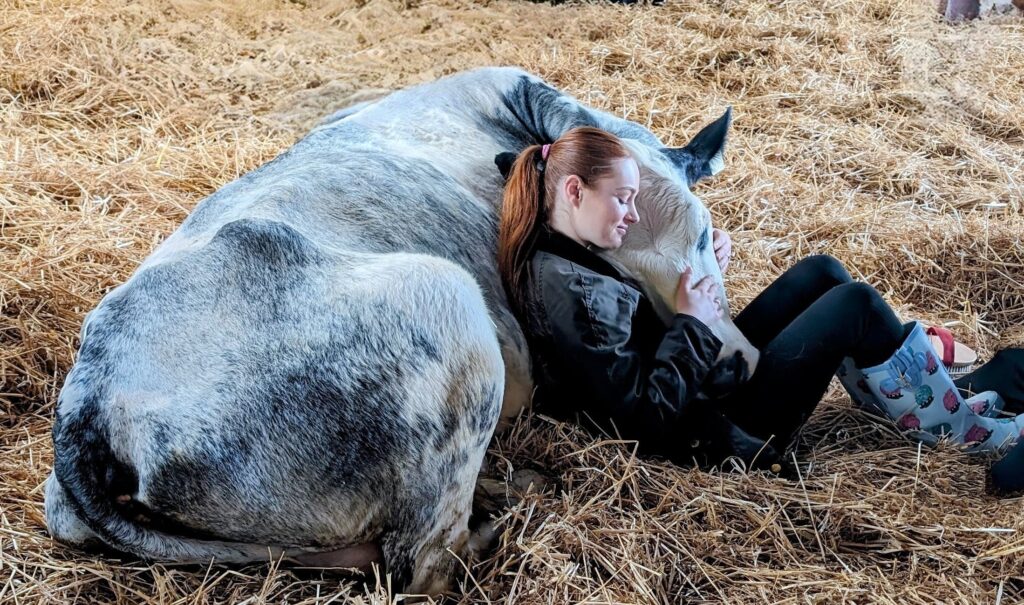Donald Scherber bought a Minnesota dairy farm in 1958. His son, John, bought it from him in 1995 and will probably pass it down to his children.
For decades, the family has made a living selling the milk of their dairy cows. But recently, Scherber’s Morningstar Dairy has become known in the Minneapolis area for another business: cow cuddling.
Donald Scherber’s grandchildren, Quinci Schmidt and Caleb Scherber, created the side business as a fun revenue source, charging visitors to cuddle their calves for 30 minutes at a time — while classical music plays in a pen.
Cow cuddling isn’t new: It grew in popularity when people were seeking connection during the coronavirus pandemic. But it has taken on new meaning in recent months for farmers who are looking for extra revenue sources amid decreasing dairy prices in the United States and other parts of the world.
Some farmers train their cows by teaching them to sit and snuggle. Others only use calves for cuddling since they’re smaller and learning to trust people.
Once the cows are ready, some lie their heads on people’s laps and fall asleep. People relax amid hay bales by placing their heads near the cows’ chests and listening to their slow resting heartbeats, farmers said.
It’s similar to having a dog on your lap, said Fiona Wilson, whose farm in Arram, England, offers cow cuddling.
“It’s a bit like a cow’s spa day, really,” Wilson said. “They just sprawl out while people are stroking them and cuddling them.”
Looking to expand their family’s farm last year, Scherber and Schmidt were inspired to start cow cuddling after seeing Sunset View Creamery in Odessa, New York, offered the activity.
Jessica May Hoffman, co-owner of the creamery, said that as a child, she hugged heifer cows in her family’s Pennsylvania pasture when she was upset. She wanted to give others the calming experience.
“If it worked for me,” Hoffman said, “then why wouldn’t it work for everybody else?”
Hoffman, 36, calls the calves that cuddle customers a “Kindergarten group” because they are between 3 and 6 months old. Cows typically weigh 60 to 100 pounds at birth and usually grow to between 1,200 and 1,500 pounds.
Hoffman, whose farm has 40 dairy cows, said her customers range from children to near centenarians. Customers sometimes read books when lounging on cows or scratch them in their favorite spots — under their chins.
As dairy prices have decreased since July, Hoffman said the $15 she earns for every 30-minute cuddling session has helped.
While bringing in extra hundreds or thousands of dollars might not make a huge difference to large farms — ones with hundreds of cows — the income could be a help for small farms, said Christopher Wolf, an agricultural economics professor at Cornell University.
The milk supply has increased in recent years partly due to selective breeding — some farms breed their cows so they produce large quantities of milk, Wolf said. Inflation has caused fewer people to eat at restaurants — where people typically eat more dairy products — lowering the demand for those products, Wolf said.
Wolf added that trade disputes between President Donald Trump’s administration and other countries — including the enforcement of tariffs — has impacted dairy farms by increasing the price of fertilizer, machinery and other equipment.
“If we have a bad year in 2026, as far as it gets real tight or negative in profit margins, then there will be farms that exit the business,” Wolf said.
Wolf said the issue is just as prominent in Europe. In Arram, England, Wilson said her family’s farm, which she started working on as a 3-year-old, almost closed after her father’s death in 2022.
The business of producing and selling milk had stopped being profitable, Wilson said.
“We’ve had to make it work because otherwise we would have lost it and that would have been heartbreaking — absolutely heartbreaking,” said Wilson, 56. “I don’t know what I would’ve done.”
The solution: turning the milking parlor into a cow cuddling pen.
Wilson sold about 95 dairy cows in 2022 but kept five that she trained for about a year to draw close to people and nuzzle: Cloud, Crocus, Keri, Soft Face and Snowflake.
The farm now has 13 dedicated cuddlers — two Highland cattle, three dairy cows, one British Blue, an Aberdeen Angus, a Simmental cattle, and some Highland and dairy cow mix breeds. While the Highland cattle have long, thick hair, other cows have smooth skin that feels like a warm pillow, Wilson said.
The farm has stopped selling milk and instead offers a roughly four-hour event for about $150 that includes cow cuddling and tours of the farm.
“We get a lot of people saying, ‘Best day ever,’ which is absolutely wonderful,” Wilson said. “The smiles on people’s faces, it’s priceless. … It makes all the hard work seem worth it.”
In Rogers, Minnesota, the Scherber’s roughly 220-acre farm is open to visitors three to four afternoons per week to cuddle three calves: Maui, Maye, Mandarin. While only a handful of people signed up when the farm started cow cuddling in the summer of 2024, Caleb Scherber said the activity exploded in interest this past summer. The spike came a few months after the Minnesota-based newspaper Dairy Star wrote about the cuddling program.
“I don’t think I ever thought it’d be as popular as it is,” said Scherber, 34.
Now, he said, people are already starting to schedule appointments for March.
The post Cow cuddling gives farms boost amid dropping dairy prices
appeared first on Washington Post.




